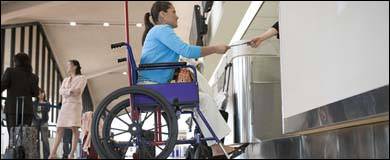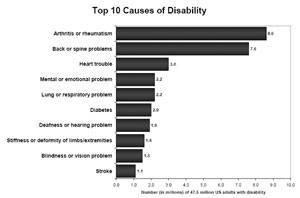Number of U. S. Adults Reporting a Disability is Increasing
 47.5 million US adults report a disability; more than one-third are aging "baby boomers." Increasing physical activity, and reducing or preventing obesity and tobacco use can eliminate some of the underlying causes of disability for some people and prevent secondary conditions in those already affected.
47.5 million US adults report a disability; more than one-third are aging "baby boomers." Increasing physical activity, and reducing or preventing obesity and tobacco use can eliminate some of the underlying causes of disability for some people and prevent secondary conditions in those already affected.
 A new CDC study shows that 47.5 million US adults (21.8%) reported a disability [1] in 2005, an increase of 3.4 million from 1999. Arthritis or rheumatism continues to be the most common cause of disability, while back or spine problems and heart trouble round out the top three causes. The number of people identifying the top two musculoskeletal conditions as the cause of their disability is increasing, but the number of people identifying heart disease as the cause of their disability is decreasing.
A new CDC study shows that 47.5 million US adults (21.8%) reported a disability [1] in 2005, an increase of 3.4 million from 1999. Arthritis or rheumatism continues to be the most common cause of disability, while back or spine problems and heart trouble round out the top three causes. The number of people identifying the top two musculoskeletal conditions as the cause of their disability is increasing, but the number of people identifying heart disease as the cause of their disability is decreasing.
Among adults reporting a disability, the most commonly identified limitations were difficulty walking 3 city blocks (22.5 million, 10.3%) and climbing a flight of stairs (21.7 million, 10.0%). That means that 1 in 10 adults reporting a disability have trouble walking a distance equal to walking from the parking lot to the back of a large store or through a mall. The number of people reporting a disability increases with age, and women have a higher prevalence of disability than men at all ages. There are approximately as many "baby boomers" (ages 45–64; 17.3 million) affected now as older adults (age 65+, 18.1 million). Given the size of the baby-boom generation, the number of adults with disability is likely to increase dramatically as the baby boomers enter into higher risk age groups over the next 20 years.

U.S. Census Bureau, 2004 Survey of Income and Program Participation, Wave 5, June-November 2005.
Click to view larger image.
Increasing physical activity, and reducing or preventing obesity and tobacco use can eliminate some of the underlying causes of disability for some people and prevent secondary conditions in those already affected.
[1] NOTE: Disability was defined as a “yes” response to at least one of the following limitation categories: 1) use of an assistive aid (cane, crutches, walker, or wheelchair), 2) difficulty performing activities of daily living (ADLs) or instrumental activities of daily living (IADLs), or specified functional activities, 3) one or more selected impairments, or 4) limitation in the ability to work around the house or at a job or business.
More Information
- Read more about this CDC and US Census Bureau study: Hootman JM, Brault MW, Helmick CG, Theis KA, Armour BS. Prevalence and most common causes of disability among adults—United States, 2005. MMWR, 2009;58(16);421-426.
- Send an eCard and encourage friends and family to increase their physical activity.
- Disability and Health
- Physical activity
- Obesity
- Smoking & Tobacco Use
- Arthritis
- Arthritis Intervention Program
- Heart Disease
- Guide to Community Prevention Services (Community Guide)

- Back Pain, National Institutes of Health
Current Features
Need info on a
different topic? See



